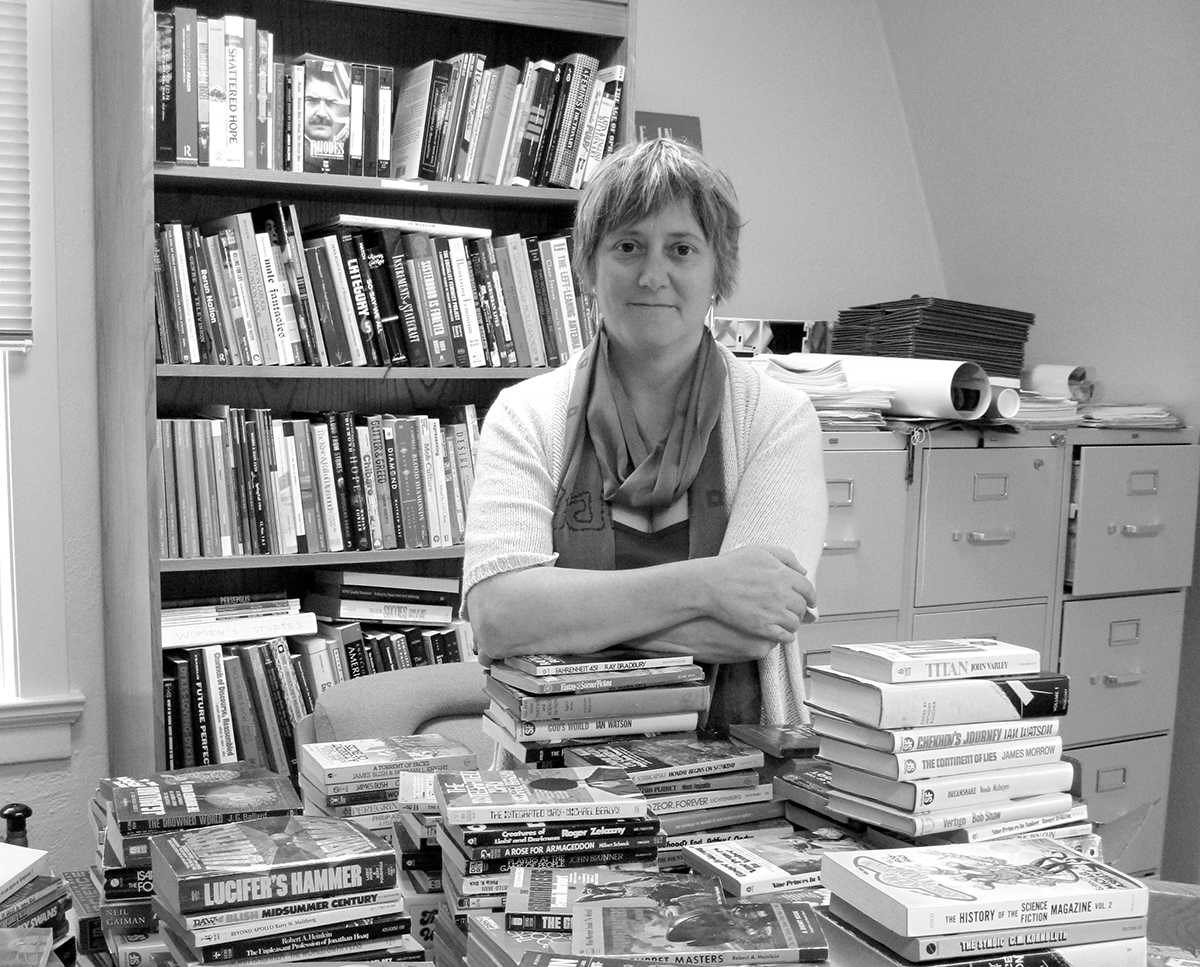
by Carol Stabile, Director , Center for the Study of Women in Society, Professor, UO School of Journalism and Communication and the Department of Women’s and Gender Studies
Research is a funny thing, I’ve learned over years of working with graduate students and faculty members. Never a one-size-fits-all process, it’s rarely straightforward, especially when it comes to interdisciplinary work that needs to reckon with scholarship and perspectives other than those of the scholar’s home discipline. The work of interdisciplinary feminist researchers is made even more complex because of the need to grapple with relations of power, like gender, race, class, sexuality, ability, and other dimensions of oppression too long to list, but that make for deadly combinations.
Think of it this way: you’re researching how “Ugly Laws” (ordinances that made it illegal for persons with “unsightly or disgusting” disabilities to appear in public) affected women in San Francisco, California. The problem with this formulation is, as gender scholars have argued over the past thirty years, laws like this affected different groups of women in very distinct ways, depending on race, ethnicity, class, and ability. In order to do justice to the research question, then, the researcher needs to look at relationships among gender and race and ethnicity and class and ability, if she wants to understand how these ordinances affected this diverse, unwieldy category of “women.” Even if she narrows the focus further—perhaps with a concentration on Chinese women—she still needs to have a sense of how the laws affected other groups of women in order to evaluate the specific impact on Chinese women.
It might help to think of this by way of another analogy. When Rachel Carson wrote Silent Spring (Houghton Mifflin, 1962), the book galvanized attempts to ban DDT, a pesticide toxic to many birds and mammals. Years ago, environmental activists often focused on a single chemical and its effects. But today, they understand that what they need to be studying—in all its complexity—are not single causes, but the relationships among chemical compounds, which interact with one another and in ecosystems in intricate and tricky ways.
If we think about discrimination and oppression as forms of social pollution, we can carry this analogy further and say that twenty-first century feminist researchers and their allies need to be studying the relationships among oppressions in their specific historical and cultural contexts, a job that’s manifestly more complicated than previous ways of knowing. In intellectual cultures accustomed to telling straightforward narratives about single causes and discernible effects, it goes without saying that research like this can be challenging.
At CSWS, we recognize that this kind of research requires resources. Many of us have watched as support for social scientific and humanistic research on gender has slowed to a trickle. In this context, the funding CSWS provides for research that’s innovative, unusual, creative, and unorthodox makes an enormous difference in the research of graduate students and faculty researchers who study the multiple causes and interactions of oppressive cultures, as well as strategies for resistance. In the years I’ve been director, very few days go by when I don’t quietly thank Jane Grant and her husband, William Harris, for their gift that makes the work of CSWS possible.
The impact of the Harris gift is also difficult to assess. I could tell you that we’ve funded over two million dollars worth of grants. I could tell you that CSWS grantees have gone on to publish dozens of books, secured multimillion-dollar grants at UO and elsewhere, and won numerous awards. I could tell you stories about faculty awardees, like anthropologist Lynn Stephen, who used her funding to conduct research that was published as a book in 2005, titled Zapotec Women: Gender, Class, and Ethnicity in Globalized Oaxaca. I could share the words of professor of French and vice provost of academic affairs Barbara Altmann, who expressed her gratitude for the support a CSWS grant gave her “at a crucial transition from associate to full professor. The term off teaching it allowed gave me a chance to finish that research despite becoming department head.” Or I could point to the work of historian Elizabeth Reis, whose 2004 CSWS grant funded research for what became her influential book on intersex, Bodies in Doubt: Intersex in America, 1620-1960. I could also mention the impact of CSWS funding on professor of anthropology Aletta Biersack, who found that her CSWS award was “a powerful ‘seed’ grant for subsequent research and writing,” including research on changing marriage and sexual practices in Papua New Guinea.
Like research on gender, evaluating impact in the humanities and social sciences can be complicated. As one of our Jane Grant Dissertation winners, now a professor of speech communication at Oregon State University, put it about the funding she received in 1987, “How does one assess a particular effect of a single piece of one's life? What is the measure of the relief I felt as a single mother in graduate school to be given such largess to allow me possibilities otherwise not available?”
The support she received did not register immediately, or through the publication of a single article. Rather, rhizome-like, the impact of her grant grew and extended over years. She graduated, secured a job, got tenure, and saw two children through college. That’s impact.
Or take the work of Dr. R. Charli Carpenter, who received a Jane Grant Dissertation Award in 2002. Dr. Carpenter published her first book, Innocent Women and Children: Gender, Norms and the Protection of Civilians, in 2006. Over the years, Dr. Carpenter has, in her words, generated “empirical data on a number of understudied phenomena: gender-based violence against civilian men and boys, children born as a result of wartime sexual violence.” Dr. Carpenter has published three books in the years since she completed her PhD in political science at the University of Oregon and has served as a consultant to UNICEF on the needs of children born of wartime rape or exploitation. That’s impact.
Like Dr. Carpenter, Kate Harkness’s grant blended theory with practice. In Dr. Harkness’s case, her research focused on women’s mental health. According to her, CSWS funding resulted not only in the completion of her dissertation, but the publication of six papers published in top-tier peer-reviewed journals. Sociologist Jill Weigt similarly credits her Jane Grant Dissertation Award for an impressive scholarly output: one book and four separate articles on welfare reform.
Creativity, originality, and self-confidence don’t always go hand in hand, for feminist researchers in particular. CSWS funding gave some graduate student researchers confidence and the sense that their work mattered. Shannon Elizabeth Bell, a sociologist and grantee whose first book, Our Roots Run Deep as Ironweed: Appalachian Women and the Fight for Environmental Justice, will be published in October of this year, told us that “CSWS was the first organization that funded my research. CSWS has a long history and is very well-respected, so receiving its support was a big confidence booster early in my graduate career. Receiving this funding helped me believe at a critical time in my development as a scholar that my research really mattered.” Another Jane Grant awardee wrote of the funding she received decades ago, “It may have been twenty-two years ago, but I still remember the incredible feeling of affirmation when I received the Jane Grant Dissertation Fellowship Award. During a doctoral program, one can become disoriented and lose perspective—especially after taking the graduate school vows of obedience, celibacy, and poverty! The timing of the award was perfect. It told me that my work was worthy and that there would be life after graduate school!”
Although CSWS specifically funds research, research directly impacts teaching as well. Lea Williams, now an associate professor, told us that the research her Jane Grant Award supported allowed her to develop several new courses over a period of years. Teaching at a private military college, she observed that “the research I did about women and war has been enormously useful in introducing students here to the way conceptions of gender contribute to the development of war narratives, a view most of the students know little about.” Another grantee told us that her research allowed her to teach a lecture course on gender and communication that over a period of twenty years reached more than two thousand students.
CSWS’s impact further stretches beyond college settings or conventional research publications. Seri Luangphinith used poetry from her dissertation in a workshop she conducted on indigenizing assessment on multiculturalism—showing participants what she described as “the entrenched divide between idealized multiculturalism and indigeneity.” Kathleen M. Ryan used her research grant to visit archives on the East Coast for an oral history on the WAVES of World War II, a project that she is currently turning into a feature-length film. And the Fembot Project—an online platform devoted to publishing feminist research, launched with CSWS support and sustained with additional funding from the School of Journalism and Communication—has reached tens of thousands of readers in just over a year of publishing.
A lesser known part of Jane Grant and William Harris’s story lies in their mutual love of gardening. In the late 1930s, they bought an old barn in Litchfield, Connecticut—a weekend retreat for the two journalists (Harris was editing for Fortune Magazine, Grant continued to write freelance columns and features) from their working lives in New York City. They quickly discovered that American gardening in the 1940s was backward, to say the least, and their efforts to procure new plants, to innovate in garden design, and to share the knowledge they were acquiring resulted in the founding of White Flower Farm, a pioneering nursery that remains in operation today (proceeds of Harris’s sale of White Flower Farm became part of his gift to UO). Over the decades, Harris’s gift to CSWS has provided seed funding that has transformed—and continues to transform—the University of Oregon itself. CSWS funding helped create the Center for Latino/a and Latin American Studies, and it has supported the Center on Diversity and Culture and the Center for Race, Ethnicity, and Sexuality Studies (the last, unfortunately, a casualty of defunding). The seeds of that original gift, and the work of generations of feminist scholars and leaders—Joan Acker, Miriam Johnson, Marilyn Farwell, Sandi Morgen, and many others—that made those seeds flourish here in Eugene, continues to unfold today in the research, teaching, and activism of a new generation of feminist scholars and researchers.
—Carol Stabile is in her final of six years as director of the UO Center for the Study of Women in Society. A professor in the School of Journalism and Communication and the Department of Women’s and Gender Studies, she is the author of Feminism and the Technological Fix, editor of Turning the Century: Essays in Media and Cultural Studies, co-editor of Prime Time Animation: Television Animation and American Culture, and author of White Victims, Black Villains: Gender, Race, and Crime News in US Culture. She is currently finishing a book on women writers and the broadcast blacklist in the 1950s, entitled Black and White and Red All Over: Women Writers and the Television Blacklist, and working on research on gender in massively multiplayer online games. She is also a founding member of Fembot, a scholarly collaboration promoting research on gender, media, and technology.

